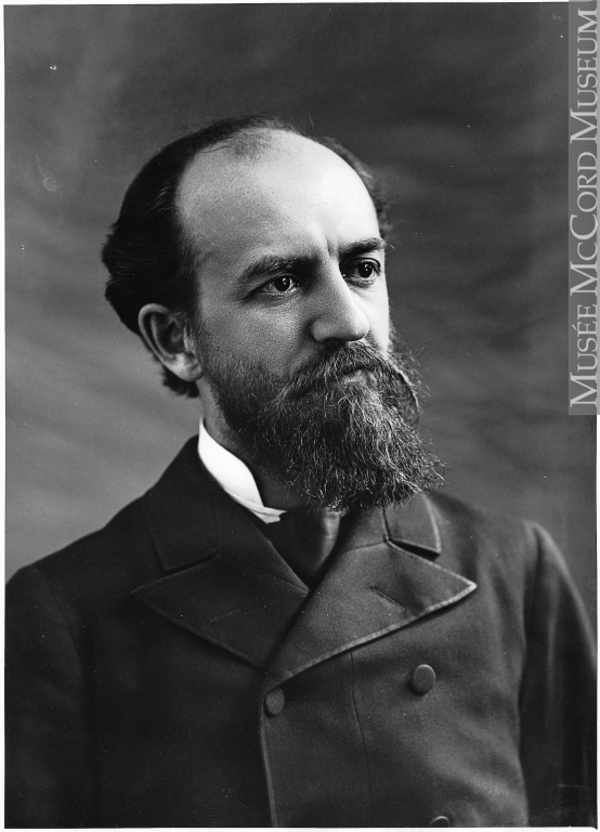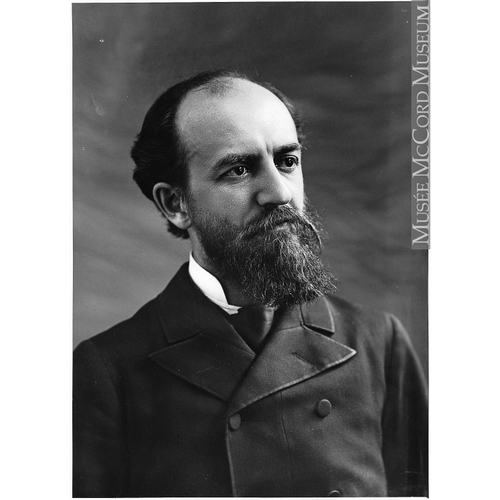
Source: Link
HARRINGTON, BERNARD JAMES, mineralogist, professor, office holder, and author; b. 4 Aug. 1848 in St Andrews (Saint-André-Est), Lower Canada, son of William Harrington, a merchant, and Laura Seymour; m. 7 June 1876 Anna Lois Dawson, eldest daughter of John William Dawson*, in Montreal, and they had four sons and five daughters; d. there 29 Nov. 1907 and was buried 2 December in Mount Royal Cemetery in Outremont.
Bernard J. Harrington’s grandfather, John Harrington, worked as a millwright in Massachusetts before emigrating to Lower Canada in 1802. He settled in the village of St Andrews, in Argenteuil county. From 1803 to 1805 he helped to set up the first paper-mill in Canada, with some American businessmen among others. His income soon enabled the Harrington family to buy an imposing house near the village, where William, the father of Bernard, was born.
From an early age Bernard suffered from problems with his eyesight, and he spent little time in school. He finished his early education under private teachers. In 1865 he entered McGill College where, four years later, he received a ba in natural science with first-class honours. He obtained a phd in mineralogy, with distinction, from the Sheffield Scientific School of Yale College in New Haven, Conn., in 1871. He is believed to have been the first Canadian to receive a doctorate from the college. His thesis dealt with the Siemens-Martin process for producing steel.
In 1871, shortly after returning to Canada, Harrington assisted John William Dawson, the principal of McGill College and later his father-in-law, in his research on Prince Edward Island. Together they studied the economic resources of the Island and assessed the possibilities of finding coal there. In February 1871 McGill College, fearing it would lose students to the University of Toronto, had launched an urgent appeal for funds to improve instruction in science. Some of those who responded, including John Henry Robinson Molson and Peter Redpath, pledged $400 each for five years to provide a salary for a professor. Harrington was offered a teaching position in the brand-new department of practical science, which soon became the department of applied science. At first he lectured in chemistry, mineralogy, and assaying. The college had no money to include metallurgy in the curriculum, but Harrington went to the British Isles during the summer to visit the smelting works in the chief mining and manufacturing centres, and he subsequently taught this subject for many years. On returning to Montreal, he was appointed in 1872 to succeed Thomas Sterry Hunt* as chemist and mineralogist to the Geological Survey of Canada. Its offices were in Montreal and Harrington held this post in addition to his teaching position until his increasingly heavy responsibilities at the college forced him to resign from the survey in 1879. In 1883 he was appointed to the David Greenshields chair of chemistry and mineralogy. Once again he held two positions, but he gave up his post as lecturer in mining and metallurgy in 1891. During the course of his career he was also president of the Natural History Society of Montreal, president of the chemistry and physics section of the Royal Society of Canada in 1890, and vice-president of the chemistry section of the British Association for the Advancement of Science at its meeting in Toronto in 1897. His chief scientific interests lay in the fields of inorganic chemistry and mineralogy. He was the first Canadian scientist to take an interest in petrography and to make a significant scientific contribution to it.
With nine children, the Harrington family was sometimes in a difficult financial situation. Mrs Harrington, who had little time to use her artistic talents, cheerfully declared that it was more important to furnish the mind than the house, but her husband did not pass up opportunities to earn additional income. Outside organizations, both Canadian and American, regularly called on him to assess, for instance, the potential of copper mines. Shortly before his death Harrington sold his personal collection of minerals for $3,000 to James Douglas, a recognized metallurgical expert, who then donated it to McGill University.
In his 36-year teaching career at McGill University, Harrington trained generations of students. Some of them went on to hold leading positions in the field of mining in Canada and the United States. Warm and loyal, always ready to take on a new task, he gave freely of his time and was highly regarded as a professor. Harrington had a hand in developing the plans for the Macdonald Chemistry Building, opened in 1898, of which he was the proud director until his death in 1907. He devoted his spare time to gardening, woodworking, and, above all, music, for which he had a genuine talent. He was involved as editor and composer in the production of the McGill College Song Book in 1885. One of his compositions, the “Harrington march,” enjoyed a long period of fame in his native village.
A portrait of Bernard James Harrington by Robert Harris* is located in the Macdonald Chemistry Building, McGill Univ., Montreal. Three family photograph albums and two framed photographs, one of Bernard and the other of his wife, Anna, are in the possession of Conrad Hastings Harrington of Westmount, Que., a great-grandson.
Harrington is the author of Life of Sir William E. Logan, Kt., ll.d., f.r.s., f.g.s., &c., first director of the Geological Survey of Canada . . . (Montreal, 1883) and of a number of reports issued in scientific journals or separately; these publications are listed in Geologic literature on North America, 1785–1918, comp. J. M. Nickles (2v., Washington, 1923–24), 1: 456–57, and CIHM Reg.
Materials relating to Harrington at the MUA include his papers, covering the period 1871–1903, within the Dawson–Harrington coll. (MG 1022); chemistry department records (RG 32, c.67, c.70–c.75); and a biography prepared by family members (HARB 992).
AC, Montréal, État civil, Congrégationalistes, Emmanuel Congregational Church (Montreal), 2 Dec. 1907. ANQ-M, CE1-120, 7 juin 1876; CE1-115, 18 sept. 1848. Canadian men and women of the time (Morgan; 1898). S. B. Frost, McGill University: for the advancement of learning (2v., Montreal, 1980–84), 1: 226, 274; 2: 34–39. RSC Trans., 3rd ser., 2 (1908), proc.: xxiv–xxvi (obit. notice and portrait facing p.xxiv). J. F. Snell, Macdonald College of McGill University: a history from 1904-1955 (Montreal, 1963). B. N. Wales, Memories of old St. Andrews and historical sketches of the seigniory of Argenteuil (Lachute, Que., 1934).
Cite This Article
Danielle Ouellet, “HARRINGTON, BERNARD JAMES,” in Dictionary of Canadian Biography, vol. 13, University of Toronto/Université Laval, 2003–, accessed December 28, 2025, https://www.biographi.ca/en/bio/harrington_bernard_james_13E.html.
The citation above shows the format for footnotes and endnotes according to the Chicago manual of style (16th edition). Information to be used in other citation formats:
| Permalink: | https://www.biographi.ca/en/bio/harrington_bernard_james_13E.html |
| Author of Article: | Danielle Ouellet |
| Title of Article: | HARRINGTON, BERNARD JAMES |
| Publication Name: | Dictionary of Canadian Biography, vol. 13 |
| Publisher: | University of Toronto/Université Laval |
| Year of publication: | 1994 |
| Year of revision: | 2020 |
| Access Date: | December 28, 2025 |



